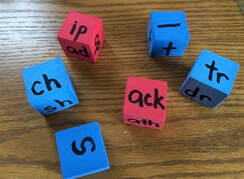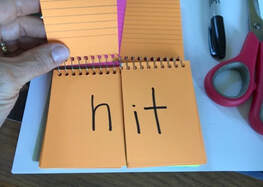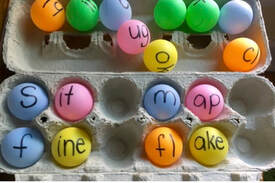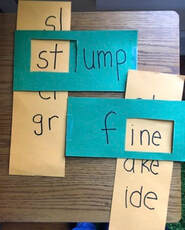Home and School Spelling Activities for Beginning Readers (Part 2): Spelling and Reading Patterns8/19/2020
When I first started to present workshops and trainings, I often told teachers my two classroom mantras were “read, read, read” and “write, write, write.” Reflecting on my instruction at the end of a teaching day, if I felt I had given my students many opportunities to read and write, then I knew my instruction was on the right track. After deeply diving into brain-based reading, however, I’ve added a third teaching mantra: “Patterns, patterns, patterns!” Studying Patterns and Building Words Once students have mastered sound-letter associations, such as the sound /b/ is represented by a B and /sh/ is represented by the S-H digraph, they are ready to begin exploring larger patterns called phonograms, often called word chunks or word families. From this point on, I will use the terms interchangeably. Typically, word families are presented at the rime level, which is the part of a one-syllable word that stretches from the first vowel to the end of the word. For example, the rimes of bake, ink, home, and clump are ake, ink, ome, and ump. Patterns are terrifically important because they move children toward whole word reading and spelling. Teachers who teach pattern recognition hijack the brain’s natural ability to recognize patterns. But don’t worry, this hijacking is a positive act. When we teach students to notice patterns, we help them see how words are made up of and relate to one another through predictable chunks. Keeping one chunk the same (the rime) but changing its initial letter or letters (the onset) produces a list of words that rhyme. Also, when students engage in activities that focus on letter patterns and their associated sounds, they may be more likely to recognize the chunk in other written words (which helps them to decode), as well as hear the sound chunk in words they want to write (which helps them to encode). Researchers Wylie and Durrel famously showed that some word families are more common than others (Wylie & Durrel, 1970). They referred to these families as phonograms. Figure 6.8 gives a list of the 37 phonograms they identified as most common. The list is an excellent starting point for phonics-spelling instruction in the primary grades.  Activities that show how words work at the pattern level take many forms. My favorites involve manipulation, especially manipulation of materials that are easy to store, transport, and clean up afterwards. All the following activities can be easily made; many can be purchased. When you first introduce an activity, model its use. Then model it again! If you don’t have enough materials to run the activity for a whole group, consider pairing the kids (with each pair getting a white board, egg carton, magnetic journal, etc.) or using the materials only in small group settings or in a word work center. Foam blocks. You will need two sets, one set with phonograms or families such as ack, ain, ill, and ot, and one set with consonant and consonant blends, like d, g, br, and fl. Students work in pairs. One student tosses each block and puts the blocks together to form a word. It might be a real word; it might be a nonsense word. The other student reads the words. Next, the students reverse roles. You can buy blank blocks as well as blocks printed with onsets and rimes from online vendors such as Oriental Trading Post or your local craft store.  Flip books. Flip books have two sections, one comprised of onsets and one of rimes. The first flap is the onset (consonants and consonant blends), the second flap is the rime. Students create words by flipping the pages and reading each combination. Sometimes the words are real (bake, cake, flake, stake) and sometimes not (dake, glake, prake). Onset-rime flip books can be purchased, but it’s easy to make them; all you need is a spiral bound book of index cards. Cut the cards down the middle, write in the onsets and rimes with a marker. Card books in colors (yellow, green, blue) let you categorize the rimes: yellow for vowel-consonant-E (lake, lade, lime), pink for vowel teams (steam, stow, stay). Students can work and read on their own or in pairs (one flipping and one reading).  Ping pong balls in egg cartons. The balls typically can be purchased in bulk for under $15 and are available in various colors. You could buy two colors, one for onsets (like t, s, p, gr, sh, fl) and one for rimes (like ame, ill, est, ore, and unk). You’ll also need a sharpie and an empty egg carton. Organize the onsets and rimes in ways that are most beneficial to your students. (See Figure 6.8c.) Students pick one onset (t) and one rime (ame) and then pair them to make a word (tame). Next they read the word. Then they either swap in a new onset (sh to make shame), bring in a new rime (est to make test) or put both balls back and build a completely new word.  Wheels and sliders. Students turn the wheel or slide the slider to form new words and then read the words. Wheels and sliders can be purchased but you can also make your own with colored cardstock and round-headed brass fasteners. Personal white boards.
On their board, students write down the target rime and then spell and read words by swapping beginning letters in and out. If you want to make your own board, go to Lowe's or Home Depot and buy a 4 x 8 sheet of white panelboard, from which you can get twenty-four 12 x 16-inch rectangles. If you ask nicely, it's a good bet someone at the store will cut the pieces for you right then and there. Take the pieces home, sand the edges with fine sandpaper and boom, you have 24 white boards for less than a buck a piece! Comments are closed.
|
Mark WeaklandI am a teacher, literacy consultant, author, musician, nature lover, and life long learner.
|

 RSS Feed
RSS Feed